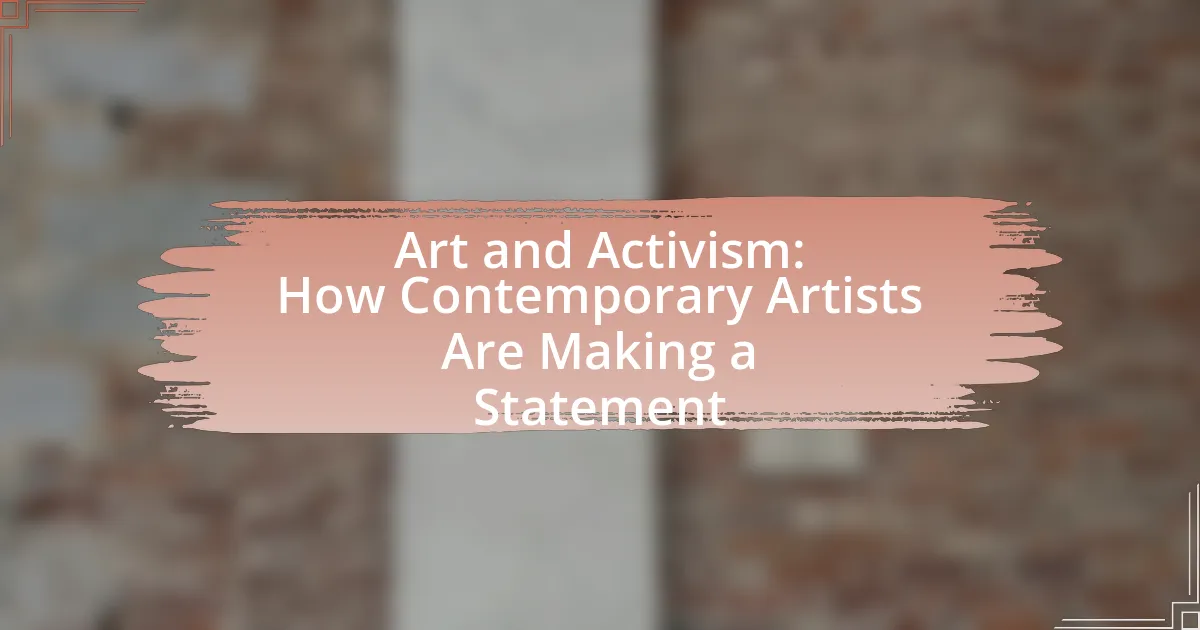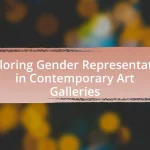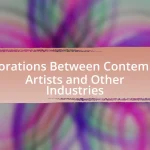The article “Art and Activism: How Contemporary Artists Are Making a Statement” explores the intrinsic relationship between art and activism, highlighting how artists utilize their work to address social issues and inspire change. It examines historical and contemporary examples of art that have sparked social movements, such as Picasso’s “Guernica” and Banksy’s street art, while discussing the various forms of artistic expression, including visual art, performance, and digital media. The article also delves into the psychological impacts of art on audiences, the importance of community engagement in activist projects, and the challenges artists face in ensuring diverse voices are represented. Additionally, it outlines practical steps artists can take to enhance their activism and the resources available for those looking to engage in social change through art.
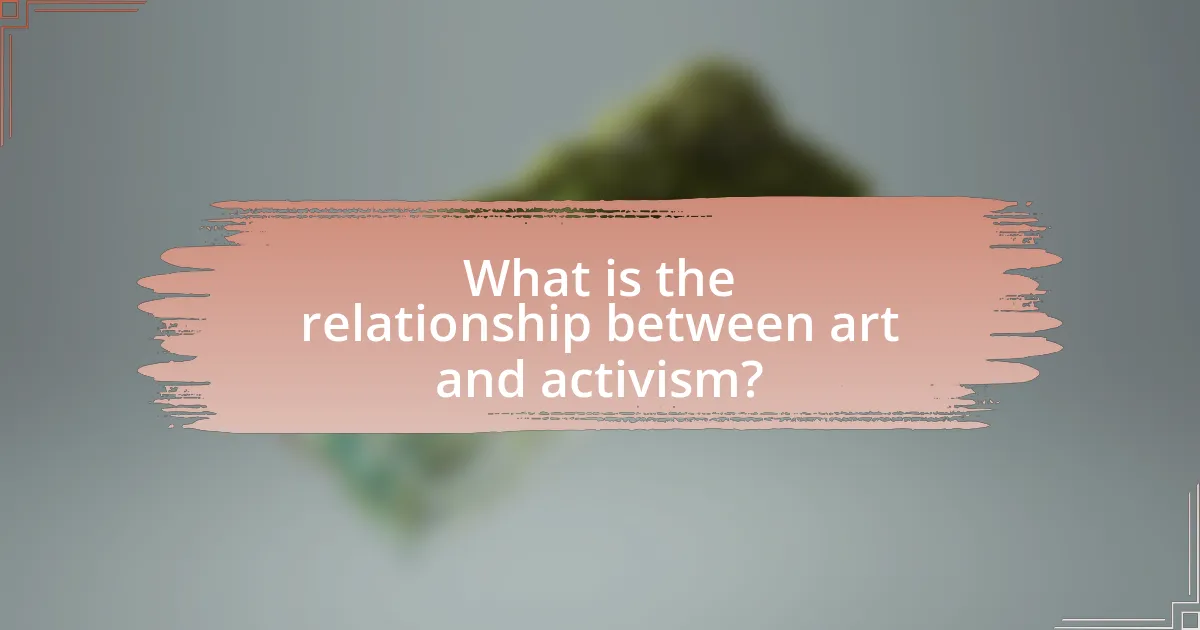
What is the relationship between art and activism?
Art and activism are intrinsically linked as art serves as a powerful medium for social change and political expression. Artists often use their work to raise awareness about social issues, challenge the status quo, and inspire action among audiences. Historical examples include the use of visual art during the civil rights movement, where artists like Jacob Lawrence depicted the struggles of African Americans, effectively mobilizing public sentiment. Additionally, contemporary movements such as street art and performance art continue to address issues like climate change and racial injustice, demonstrating that art can provoke dialogue and foster community engagement. This relationship underscores the role of art not just as a form of aesthetic expression but as a catalyst for activism and societal transformation.
How have contemporary artists used their work to address social issues?
Contemporary artists have utilized their work to address social issues by creating pieces that provoke thought, inspire dialogue, and raise awareness about topics such as inequality, climate change, and human rights. For instance, artists like Ai Weiwei have highlighted the refugee crisis through installations that depict the struggles of displaced individuals, while Banksy uses street art to comment on political and social injustices, effectively reaching a broad audience. These artistic expressions not only reflect societal challenges but also encourage public engagement and activism, demonstrating the power of art as a tool for social change.
What are some notable examples of art that has sparked social change?
Notable examples of art that has sparked social change include Pablo Picasso’s “Guernica,” which powerfully depicts the horrors of war and has become an anti-war symbol since its creation in 1937. Additionally, the AIDS Memorial Quilt, initiated in 1987, serves as a poignant tribute to those lost to AIDS and has raised awareness about the epidemic, influencing public policy and attitudes towards the disease. Another significant example is the street art of Banksy, whose works often address social issues such as poverty, war, and consumerism, prompting discussions and actions around these topics. These artworks have not only resonated with audiences but have also catalyzed movements and policy changes, demonstrating the profound impact of art on society.
How do artists choose the issues they want to address through their work?
Artists choose the issues they want to address through their work based on personal experiences, societal observations, and cultural contexts. This selection process often reflects their values, beliefs, and the desire to provoke thought or inspire change. For instance, artists like Ai Weiwei focus on human rights and freedom of expression, drawing from their own experiences with oppression. Similarly, the work of Kara Walker addresses race and identity, influenced by historical narratives and personal heritage. These choices are often informed by current events, social movements, and the artist’s own identity, allowing them to engage with relevant issues that resonate with their audience.
Why is art an effective medium for activism?
Art is an effective medium for activism because it transcends language barriers and evokes emotional responses, making complex social issues more accessible. Through visual imagery, performance, and other artistic expressions, artists can communicate powerful messages that resonate with diverse audiences. For instance, the use of street art during the Arab Spring effectively mobilized communities and raised awareness about political oppression, demonstrating art’s capacity to inspire action and foster dialogue. Additionally, studies show that art can enhance empathy and understanding, which are crucial for social change, as evidenced by the impact of campaigns like “The AIDS Memorial Quilt,” which humanized the AIDS crisis and galvanized public support for policy reform.
What psychological impacts does art have on audiences regarding activism?
Art significantly influences audiences’ psychological responses to activism by evoking emotions, fostering empathy, and motivating action. Through visual imagery, performance, and narrative, art can create a visceral connection to social issues, making them more relatable and urgent. For instance, studies have shown that emotionally charged artworks can increase viewers’ empathy levels, leading to a greater understanding of marginalized communities and their struggles. Research published in the journal “Psychology of Aesthetics, Creativity, and the Arts” indicates that exposure to art related to social justice can enhance individuals’ willingness to engage in activism, as it often inspires a sense of shared responsibility and collective action. Thus, art serves as a powerful tool in shaping public perception and encouraging proactive responses to societal challenges.
How does visual art communicate messages differently than other forms of activism?
Visual art communicates messages differently than other forms of activism by utilizing visual imagery to evoke emotional responses and provoke thought without relying on verbal language. This non-verbal communication allows for a broader interpretation, as viewers can engage with the artwork based on personal experiences and perspectives. For instance, the use of powerful imagery in works like Picasso’s “Guernica” has historically conveyed the horrors of war and suffering, transcending language barriers and fostering a universal understanding of its themes. Additionally, visual art can create immediate impact through its aesthetic appeal, often capturing attention more effectively than written or spoken words, as seen in street art movements that address social issues in public spaces.
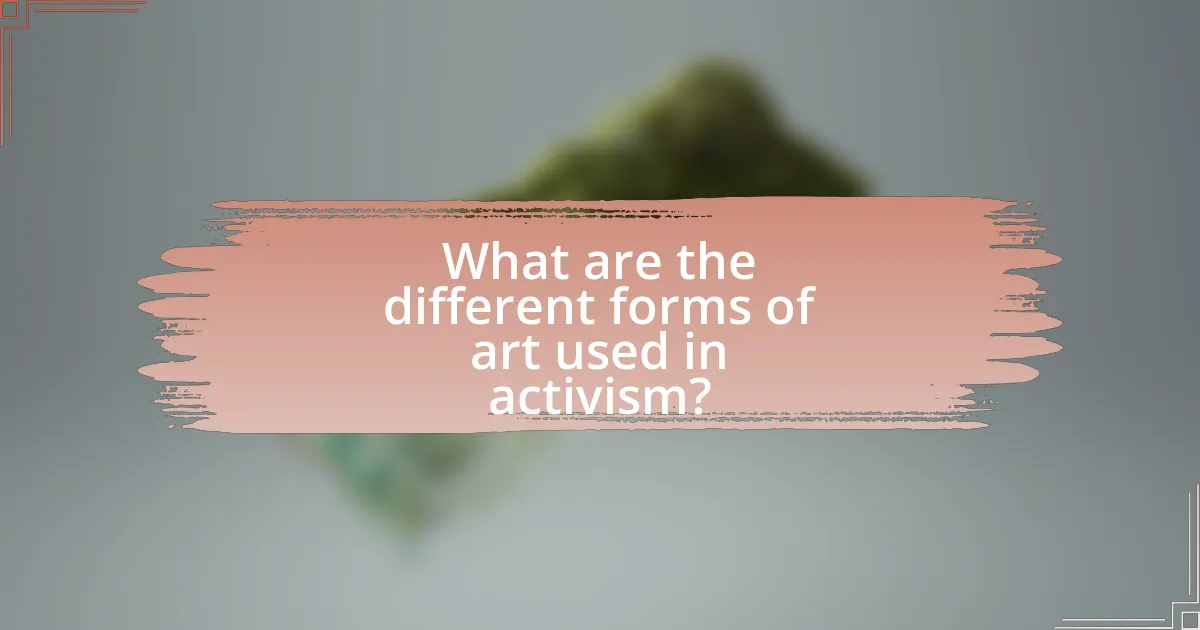
What are the different forms of art used in activism?
Different forms of art used in activism include visual art, performance art, music, literature, and digital media. Visual art, such as graffiti and murals, often conveys powerful messages in public spaces, exemplified by works like Banksy’s politically charged street art. Performance art engages audiences through live actions that provoke thought and discussion, as seen in the works of artists like Marina Abramović. Music serves as a rallying cry for social movements, with protest songs historically uniting people, such as “We Shall Overcome” during the Civil Rights Movement. Literature, including poetry and essays, articulates social issues and inspires change, as demonstrated by authors like Audre Lorde. Digital media, including social media campaigns and online art, amplifies activist messages to a global audience, effectively mobilizing support for various causes. Each of these forms plays a crucial role in raising awareness and fostering dialogue around social and political issues.
How do visual arts contribute to activist movements?
Visual arts contribute to activist movements by serving as powerful tools for communication, raising awareness, and inspiring social change. Artists utilize various mediums, such as painting, sculpture, and digital art, to convey messages that resonate with audiences, often highlighting social injustices and advocating for marginalized communities. For example, the AIDS Memorial Quilt, created in the 1980s, visually represented the impact of the AIDS crisis, fostering empathy and mobilizing support for affected individuals. Additionally, street art, like the works of Banksy, often critiques political systems and encourages public discourse, making complex issues accessible to a broader audience. These artistic expressions not only capture attention but also galvanize collective action, demonstrating the significant role of visual arts in shaping and advancing activist movements.
What role does street art play in contemporary activism?
Street art serves as a powerful tool for contemporary activism by providing a platform for marginalized voices and addressing social issues. This form of art often conveys political messages, raises awareness about injustices, and fosters community engagement. For instance, during the Black Lives Matter movement, street artists created murals that highlighted racial inequality and police brutality, effectively reaching a broad audience in public spaces. Additionally, studies show that street art can influence public opinion and inspire action, as seen in campaigns against climate change where artists use visual storytelling to mobilize communities.
How do installations and performances engage audiences in activism?
Installations and performances engage audiences in activism by creating immersive experiences that provoke emotional responses and encourage critical reflection on social issues. These artistic forms often utilize visual and auditory elements to draw participants into a narrative, making complex topics more accessible and relatable. For instance, the installation “The Obliteration Room” by Yayoi Kusama transforms a white room into a vibrant space covered in colorful dots, symbolizing the impact of consumerism and environmental degradation. This interactive approach invites viewers to contribute, fostering a sense of agency and involvement in the activism represented. Additionally, performances like “The Vagina Monologues” have raised awareness about women’s rights and violence against women, mobilizing audiences to engage in discussions and actions surrounding these issues. Such art forms not only inform but also inspire collective action, demonstrating the power of creativity in driving social change.
What is the impact of digital art on activism?
Digital art significantly enhances activism by providing innovative platforms for expression and engagement. It allows activists to reach broader audiences through social media and online campaigns, effectively disseminating messages and mobilizing support. For instance, the viral spread of digital artworks during movements like Black Lives Matter illustrates how visual content can evoke emotional responses and raise awareness on social issues. Additionally, digital art can serve as a tool for documentation and storytelling, preserving the narratives of marginalized communities. The accessibility of digital tools empowers artists to create impactful works that challenge societal norms and inspire action, thereby reinforcing the connection between art and social change.
How has social media changed the landscape of activist art?
Social media has transformed the landscape of activist art by providing a platform for rapid dissemination and engagement with social issues. This shift allows artists to reach global audiences instantly, facilitating movements like Black Lives Matter and climate activism, which gained momentum through viral content. For instance, the #MeToo movement utilized social media to amplify voices and experiences, demonstrating how digital platforms can mobilize communities and inspire collective action. Additionally, social media enables artists to interact directly with their audience, fostering dialogue and collaboration that traditional art venues often lack.
What are some successful digital campaigns that have utilized art for activism?
Successful digital campaigns that have utilized art for activism include the “Fearless Girl” statue campaign, which promoted gender equality and women’s leadership by placing a statue of a girl facing the iconic Charging Bull in New York City. This campaign gained widespread attention on social media, leading to discussions about women’s rights and representation. Another example is the “Art for Black Lives” initiative, which featured artists creating works that addressed racial injustice and police brutality, raising funds for organizations like Black Lives Matter. This campaign effectively used digital platforms to amplify voices and raise awareness, demonstrating the power of art in social movements.
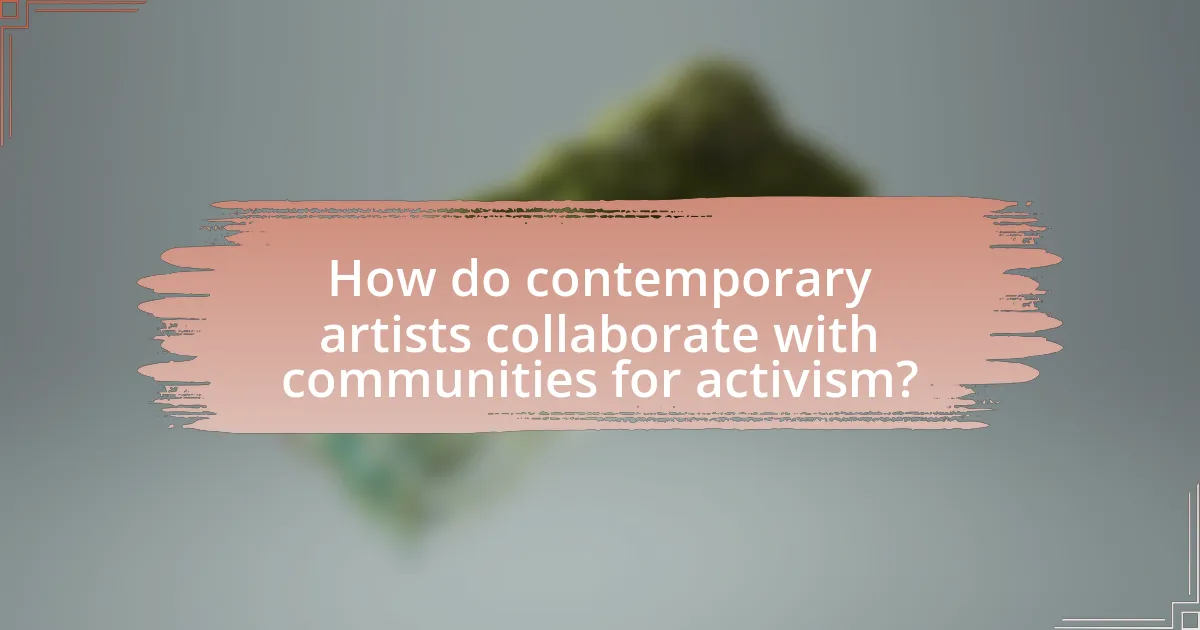
How do contemporary artists collaborate with communities for activism?
Contemporary artists collaborate with communities for activism by engaging in participatory projects that amplify local voices and address social issues. These artists often work directly with community members to co-create art that reflects their experiences and concerns, fostering a sense of ownership and empowerment. For instance, projects like “The People’s Climate March” involve artists and activists collaborating to create visual statements that raise awareness about climate change, demonstrating the effectiveness of art in mobilizing community action. Additionally, initiatives such as “The Mural Project” in various cities allow artists to transform public spaces into platforms for dialogue, highlighting community narratives and advocating for change. This collaborative approach not only enhances the visibility of social issues but also strengthens community bonds through shared creative expression.
What are the benefits of community engagement in activist art projects?
Community engagement in activist art projects enhances social cohesion and amplifies marginalized voices. By involving local communities, these projects foster a sense of ownership and collective identity, which can lead to increased participation in social issues. Research indicates that community-driven art initiatives can improve mental health and well-being, as seen in studies like “The Role of Arts in Community Development” by the National Endowment for the Arts, which highlights how collaborative art projects can reduce social isolation and promote community resilience. Furthermore, engaged communities are more likely to mobilize for change, as evidenced by the success of projects like the “People’s Climate March,” where art played a crucial role in uniting diverse groups around a common cause.
How do artists ensure that community voices are represented in their work?
Artists ensure that community voices are represented in their work by actively engaging with the community through collaboration and dialogue. This process often involves conducting interviews, organizing workshops, and facilitating discussions to gather diverse perspectives and experiences. For instance, artists like Theaster Gates have created community-based projects that incorporate local histories and narratives, ensuring that the artwork reflects the voices of the people it represents. Additionally, research shows that participatory art practices can enhance community involvement and ownership, leading to more authentic representation in artistic expressions.
What challenges do artists face when collaborating with communities?
Artists face several challenges when collaborating with communities, including differing expectations, communication barriers, and power dynamics. Differing expectations can arise when artists and community members have varying visions for the project, leading to conflicts over artistic direction and outcomes. Communication barriers often stem from cultural differences or varying levels of familiarity with artistic processes, which can hinder effective collaboration. Additionally, power dynamics can create imbalances, where artists may unintentionally dominate the creative process, sidelining community voices. These challenges are documented in studies such as “Art and Community Development: The Role of the Artist” by the National Endowment for the Arts, which highlights the complexities of collaboration in community settings.
How can artists measure the effectiveness of their activism?
Artists can measure the effectiveness of their activism through various metrics, including audience engagement, social media impact, and changes in public discourse. For instance, tracking the number of attendees at events, analyzing social media shares and comments, and assessing media coverage can provide quantitative data on reach and influence. Additionally, surveys and feedback from participants can offer qualitative insights into how the artwork resonated with the audience and prompted discussions or actions related to the cause. Research indicates that art can significantly shape public opinion; for example, a study by the University of California found that art interventions can lead to a 30% increase in awareness of social issues among viewers.
What metrics can be used to assess the impact of activist art?
Metrics to assess the impact of activist art include audience engagement, social media reach, and changes in public discourse. Audience engagement can be measured through attendance at exhibitions, participation in events, and feedback from viewers, indicating how effectively the art resonates with the public. Social media reach can be quantified by tracking shares, likes, and comments on platforms like Instagram and Twitter, which reflect the art’s visibility and influence. Changes in public discourse can be assessed through media coverage and shifts in conversations around social issues, demonstrating how activist art contributes to broader societal discussions. These metrics provide concrete evidence of the effectiveness and reach of activist art initiatives.
How do artists gather feedback from their audiences regarding their work?
Artists gather feedback from their audiences through various methods, including social media engagement, surveys, and interactive exhibitions. Social media platforms allow artists to share their work and receive immediate reactions and comments from followers, facilitating direct communication. Surveys can be distributed online or at exhibitions to collect structured feedback on specific aspects of their work. Interactive exhibitions encourage audience participation, enabling artists to observe reactions and gather insights in real-time. These methods are effective as they provide artists with valuable perspectives that can inform their future projects and enhance their connection with the audience.
What practical steps can artists take to enhance their activism through art?
Artists can enhance their activism through art by creating works that address social issues, collaborating with communities, and utilizing social media for outreach. By focusing on relevant themes such as climate change, racial justice, or mental health, artists can raise awareness and provoke dialogue. Collaborating with local organizations or activists allows artists to ground their work in community needs, ensuring that their art resonates with those directly affected by the issues. Additionally, leveraging social media platforms enables artists to reach wider audiences, share their messages, and mobilize support for their causes. These steps have been shown to amplify the impact of artistic expression in social movements, as evidenced by the success of campaigns like the “Art for Change” initiative, which highlights the role of art in activism.
How can artists effectively choose themes that resonate with their audience?
Artists can effectively choose themes that resonate with their audience by conducting thorough research on societal issues and understanding the emotional landscape of their target demographic. This involves analyzing current events, cultural trends, and audience feedback to identify themes that evoke strong emotional responses. For instance, a study by the National Endowment for the Arts found that art addressing social justice issues significantly engages audiences, as it reflects their concerns and aspirations. By aligning their work with these relevant themes, artists can create impactful pieces that foster connection and dialogue within their communities.
What resources are available for artists looking to engage in activism?
Artists looking to engage in activism can access various resources, including grants, workshops, and online platforms dedicated to social change. Organizations like the Creative Capital Foundation provide funding and support for projects that address social issues, while platforms such as Art for Change and the Center for Artistic Activism offer workshops and training to enhance activist skills. Additionally, social media channels enable artists to amplify their messages and connect with like-minded individuals and communities. These resources are essential for fostering collaboration and increasing the impact of artistic activism.
